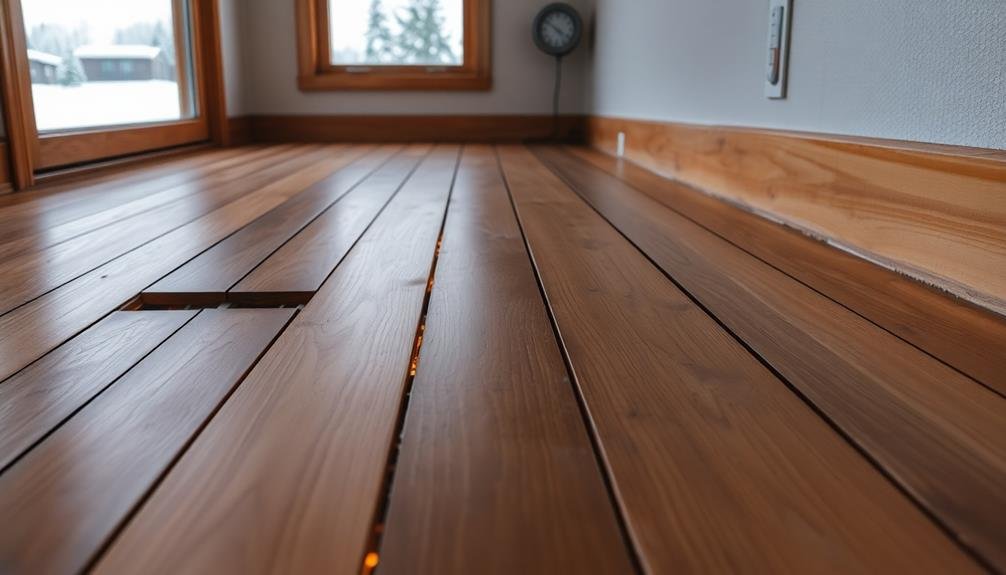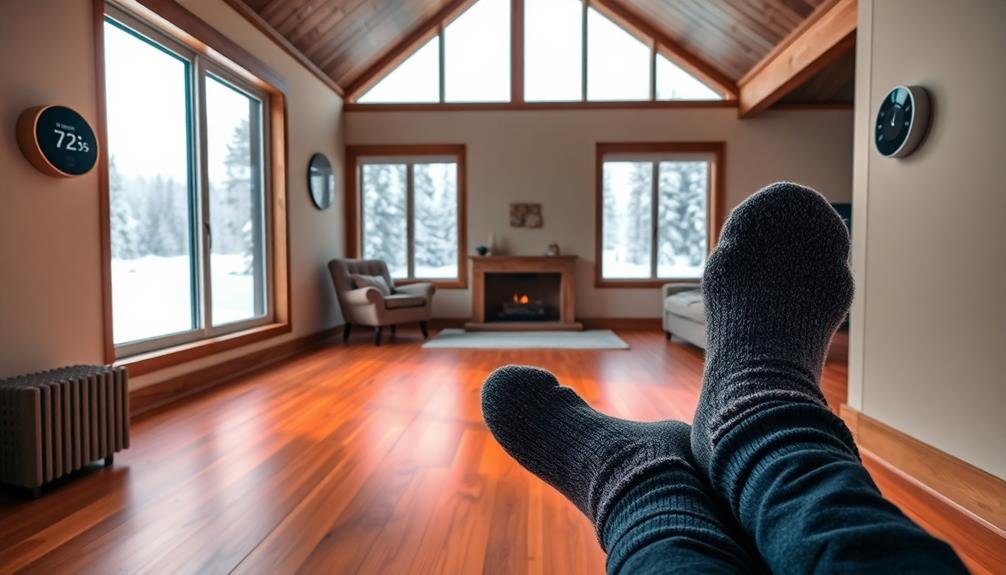To optimize radiant floor heating in frigid regions, focus on three key areas. First, choose flooring materials with high conductivity like ceramic tiles or natural stone to efficiently transfer heat. Second, insulate beneath the system using high R-value materials resistant to moisture and compression, ensuring maximum heat retention. Finally, zone your home for targeted heating, installing separate thermostats in different areas to control temperatures independently and reduce energy waste. By implementing these strategies, you'll create a cozy, energy-efficient space that combats even the coldest climates. Discover how these tips can transform your home into a warm sanctuary throughout the harshest winters.
Choose Optimal Flooring Materials

Selecting the right flooring materials is essential for maximizing the efficiency of your radiant floor heating system. You'll want to choose materials that conduct heat well and don't act as insulators.
Ceramic and porcelain tiles are excellent options, as they efficiently transfer heat from the system to the room. Natural stone, like slate or marble, also performs well but may require professional installation due to its weight.
If you prefer a warmer feel underfoot, engineered hardwood is a good choice. It's more stable than solid hardwood and can withstand temperature fluctuations better.
Avoid thick carpets or rugs, as they can trap heat and reduce the system's effectiveness. If you must use carpet, opt for a low-pile variety with a thin underpad.
Concrete is another excellent conductor of heat and works well with radiant systems. It's particularly suitable for basement installations.
For vinyl or linoleum flooring, verify it's rated for use with radiant heat to prevent damage or off-gassing.
Insulate Beneath the System
Proper insulation beneath your radiant floor heating system is vital for maximizing efficiency and comfort. Without adequate insulation, you'll lose heat to the ground or subfloor, resulting in higher energy costs and reduced heating performance. To guarantee ideal insulation, use high-quality materials specifically designed for radiant floor systems.
When insulating beneath your radiant floor heating, consider these significant factors:
- R-value: Choose insulation with a high R-value, typically between R-10 and R-20, depending on your climate and subfloor conditions.
- Moisture resistance: Opt for insulation that can withstand potential moisture exposure without compromising its effectiveness.
- Compression strength: Select insulation that can support the weight of your flooring system without compressing, which would reduce its insulating properties.
Install a vapor barrier between the insulation and the subfloor to prevent moisture damage. For concrete slabs, use rigid foam insulation boards, while for wooden subfloors, you can use fiberglass batts or foam boards.
Don't forget to insulate the edges of the floor to prevent heat loss through the perimeter. By properly insulating beneath your radiant floor heating system, you'll guarantee maximum efficiency and enjoy consistent, comfortable warmth throughout your home.
Zone for Maximum Efficiency

How can you maximize the efficiency of your radiant floor heating system? One of the most effective strategies is to implement zoning. By dividing your home into separate heating zones, you'll have greater control over temperature distribution and energy consumption.
Start by identifying areas with similar heating needs. Rooms that are frequently used, like living rooms and kitchens, should be in one zone. Bedrooms can form another zone, while less-used spaces like guest rooms or storage areas can be a separate zone.
You'll want to install thermostats in each zone to regulate temperatures independently. Zoning allows you to heat only the areas you're using, reducing energy waste. For example, you can lower the temperature in bedrooms during the day and raise it at night.
This targeted approach guarantees comfort where you need it most while minimizing heat loss in unoccupied spaces. When setting up zones, consider factors like sun exposure, insulation levels, and room size.
South-facing rooms may require less heating, while north-facing areas might need more. By tailoring your heating to each zone's specific needs, you'll optimize your system's performance and save on energy costs.
Frequently Asked Questions
How Long Does It Take for Radiant Floor Heating to Warm Up?
You'll typically wait 30-60 minutes for radiant floor heating to warm up. However, it can take up to 24 hours for the entire system to reach ideal temperature. Factors like floor material and room size affect warming time.
Can Radiant Floor Heating Be Installed in Existing Homes?
Yes, you can install radiant floor heating in existing homes. You'll need to remove existing flooring and possibly raise floor heights. It's more challenging than new construction, but it's doable with proper planning and professional help.
What's the Average Lifespan of a Radiant Floor Heating System?
You can expect your radiant floor heating system to last 20-35 years on average. It's durable, but lifespan varies based on quality, maintenance, and usage. With proper care, you'll enjoy warm floors for decades to come.
Is Radiant Floor Heating Safe for Pets and Children?
You'll find radiant floor heating is generally safe for pets and children. It doesn't emit harmful fumes or create hot spots. However, you should monitor the temperature settings and guarantee your flooring material is suitable for the system.
How Does Radiant Floor Heating Impact Indoor Air Quality?
You'll notice improved indoor air quality with radiant floor heating. It doesn't circulate dust or allergens like forced-air systems. There's no dry air or temperature fluctuations, and it reduces the risk of mold growth.
In Summary
You've now got the essentials for an efficient radiant floor heating system in cold climates. Remember to select flooring that conducts heat well, insulate thoroughly underneath, and set up smart zoning. These steps will maximize warmth and minimize energy waste. By implementing these tips, you'll create a cozy, comfortable home environment that stands up to even the harshest winters. Don't let frigid temperatures get you down – your warm floors will keep you comfortable all season long.





Leave a Reply